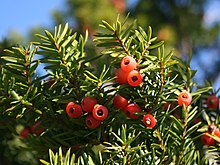Taxus cuspidata
| Taxus cuspidata | |
|---|---|

| |
| Scientific classification | |
| Kingdom: | Plantae |
| Clade: | Tracheophytes |
| Clade: | Gymnospermae |
| Division: | Pinophyta |
| Class: | Pinopsida |
| Order: | Cupressales |
| Family: | Taxaceae |
| Genus: | Taxus |
| Species: | T. cuspidata
|
| Binomial name | |
| Taxus cuspidata | |
Taxus cuspidata, the Japanese yew[2] or spreading yew, is a member of the genus Taxus, native to Japan, Korea, northeast China and the extreme southeast of Russia.
It is an evergreen tree or large shrub growing to 10–18 m tall, with a trunk up to 60 cm diameter. The leaves are lanceolate, flat, dark green, 1–3 cm long and 2–3 mm broad, arranged spirally on the stem, but with the leaf bases twisted to align the leaves in two flattish rows either side of the stem except on erect leading shoots where the spiral arrangement is more obvious.
The seed cones are highly modified, each cone containing a single seed 4–8 mm long partly surrounded by a modified scale which develops into a soft, bright red berry-like structure called an aril, 8–12 mm long and wide and open at the end. The arils are mature 6–9 months after pollination. Individual trees from Sikhote-Alin are known to have been 1,000 years old.[3]
Uses
It is widely grown in eastern Asia and eastern North America as an ornamental plant.
-
Closeup of the leaves on a stem
-
Rough bark of the tree
Toxicity
The entire yew bush, except for the fleshy berry surrounding the seed, is toxic due to a group of chemicals called taxine alkaloids.[4] Yew poisonings are relatively common in both domestic and wild animals who consume the plant accidentally.[5][6][7] Taxine B, the most toxic of the taxine alkaloids, is a cardiotoxin which works by disrupting the calcium and sodium currents of the myocardial cells.[8][9] The taxine alkaloids are absorbed quickly from the intestine and in high enough quantities can cause death due to cardiac arrest or respiratory failure.[10] Ingesting yew causes symptoms such as dizziness, dilation of pupils, abdominal pain, nausea and an irregular heartbeat.[11]
The minimum lethal dose (LDmin) of yew leaves is 3.0-6.5 mg/kg body weight for humans, 1-2 mg/kg for horses and 82.5 mg/kg for chickens.[12] There is currently no known antidotes for yew poisoning.[13]
References
- ^ Template:IUCN2006
- ^ USDA, NRCS (n.d.). "Taxus cuspidata". The PLANTS Database (plants.usda.gov). Greensboro, North Carolina: National Plant Data Team. Retrieved 8 December 2015.
- ^ https://web.archive.org/web/20070929092614/http://adm.khv.ru/invest2.nsf/pages/ru/rehabcentre.htm
- ^ Wilson, Christina R.; Sauer, John-Michael; Hooser, Stephen B. (2001). "Taxines: a review of the mechanism and toxicity of yew (Taxus spp.) alkaloids". Toxicon. 39 (2–3): 175–185. doi:10.1016/s0041-0101(00)00146-x. ISSN 0041-0101.
- ^ "JAPANESE YEW PLANT POISONING - USA: (IDAHO) PRONGHORN ANTELOPE". ProMED-mail. 24 January 2016. Retrieved 25 January 2016.
- ^ "PLANT POISONING, CERVID - USA: (ALASKA) ORNAMENTAL TREE, MOOSE". ProMED-mail. 22 February 2011. Retrieved 25 January 2016.
- ^ Tiwary, Asheesh K.; Puschner, Birgit; Kinde, Hailu; Tor, Elizabeth R. (May 2005). "Diagnosis of Taxus (yew) poisoning in a horse". Journal of Veterinary Diagnostic Investigation: Official Publication of the American Association of Veterinary Laboratory Diagnosticians, Inc. 17 (3): 252–255. doi:10.1177/104063870501700307. ISSN 1040-6387. PMID 15945382.
- ^ Toxic plants and other natural toxicants. Garland, Tam., Barr, A. Catherine., International Symposium on Poisonous Plants (5th : 1997 : Texas). Wallingford [England]: CAB International. 1998. ISBN 0851992633. OCLC 39013798.
{{cite book}}: CS1 maint: others (link) - ^ Alloatti, G.; Penna, C.; Levi, R. C.; Gallo, M. P.; Appendino, G.; Fenoglio, I. (1996). "Effects of yew alkaloids and related compounds on guinea-pig isolated perfused heart and papillary muscle". Life Sciences. 58 (10): 845–854. ISSN 0024-3205. PMID 8602118.
- ^ C., Fuller, Thomas (1986). Poisonous plants of California. McClintock, Elizabeth May, 1912-. Berkeley: University of California Press. ISBN 0520055683. OCLC 13009854.
{{cite book}}: CS1 maint: multiple names: authors list (link) - ^ 1947-, Turner, Nancy J., (2009). The North American guide to common poisonous plants and mushrooms. Aderkas, P. von., Turner, Nancy J., 1947-. Portland: Timber Press. ISBN 9781604691450. OCLC 747112294.
{{cite book}}:|last=has numeric name (help)CS1 maint: extra punctuation (link) CS1 maint: multiple names: authors list (link) - ^ Veterinary toxicology : basic and clinical principles. Gupta, Ramesh C. (Ramesh Chandra), 1949- (2nd ed ed.). Oxford: Academic. 2012. ISBN 9780123859266. OCLC 778786624.
{{cite book}}:|edition=has extra text (help)CS1 maint: others (link) - ^ Wilson, Christina R.; Hooser, Stephen B. (2018). Veterinary Toxicology. Elsevier. pp. 947–954. doi:10.1016/b978-0-12-811410-0.00066-0. ISBN 9780128114100.



